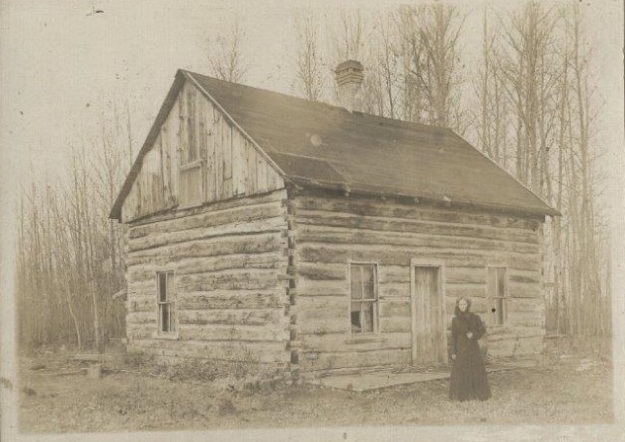Harold’s mother, Mary stands alone at the front door. She is about forty years old; a small, thin, wiry woman. Its late fall or early winter — no snow on the ground, but it must already be cold because she’s is wearing a long black coat with the fur collar turned up. She’s holding the lapels together with one hand. I peer at her face through the magnifying glass trying to make it out; its blurry, but the sharp lines of her cheekbones suggest she is smiling. This is the house the Gillespies built.
The photographer stood well back to include a complete view of the one and a half-storey cabin, yet I can clearly see the rough axe marks on the sides of the building. Few of these cabins still exist, but I am in luck as I search online – there is a reconstruction in McCreary, Manitoba and there are photos of it posted on Historic Places. These cabins were built in the tradition of homes back East (Ontario). The logs were squared off and fitted together at the corners in a dovetail fashion.
Gillespie’s cabin looks bleached and brown, but the heritage reconstruction is built from poplar and the new blond-wood logs glow in a late afternoon sun, A bonus for me is the interior photo the heritage site has posted. It shows a single room with exposed beams, exposed ceiling and the same rough hewn walls on the inside. Any chinks look well-filled on both the original and the reconstruction. There are no windows in the Sattertwaite House but in our photo there are four and they offer maddeningly minute glimpses of what they had inside.
There are half-open blinds plus curtains inside the front windows. Something is pushed near to one of the windows, but is it tumbled bed clothing, a stack of dishes or something else? The angle is curious but the detail is just not there. High up on the house is a small gable-end window, it’s covered from the inside too. With four children growing up in this house, I feel confident it must look out from a sleeping loft that William would have constructed for them The heat from the stove in winter would rise and keep little ones warm upstairs. Their parents probably slept below (to get up at night to feed the fire). The loft would have been a place of quilts and hats and socks, of giggling and blanket tussles and cold toes shoved onto warm backs, all just out of reach of the parents.
The chimney is an eye-catching contrast to the log construction. It looks professionally crafted, a barrel chimney with decorative angled-brick detailing, the drip edge flared out at the top. It is modestly handsome. It would be something you could see from the garden, from the road, from a distance as you travelled home. It looks like a solid brick promise of an even better future.
I’ve poured over the details of this photo a hundred times. There’s a small boardwalk out the front, the hint of a covered porch on the back, maybe a wheel (perhaps a bike?) round the corner on the far side of the house. Yet, when I pull the glass away from the photo this time I spot one more thing — a narrow flower bed running down the near side of the house. There is a low timber edging, the bed filled with dry, twisted stalks that probably remained until spring clean-up, and next to it a watering-can waiting for warmer weather.
****
There’s is also so much this photo doesn’t reveal. I’m left wondering: who took the photo? The grey card frame indicates a professional studio so why wasn’t Grandfather in it too? Was he too far to come in from the fields and pose with his wife, had he made a journey to town that day. Where were the children? If it was late fall/early winter and post-harvest there was no need to be at home helping out, were they gone to school? Maybe they’d gone with their father?
Did all the settling families need an official photograph of their dwelling as proof of settlement for their Land Grants so this was it? But maybe the reason was not one of meeting legal conditions. Maybe a photographer passed through the area and convinced Mary to have it taken on the spur of the moment. Would a few compliments on the sturdy nature of the house or the quality of construction have won her as a customer? Perhaps he persuaded her to have it taken to send the folks back in Ontario. Whatever the reason, we are lucky Mary was impulsive enough, proud enough or law-abiding enough to have said yes to the cameraman.

Nonni, a local historian to the area, sent through some interesting additions to this post. He says, “It is really exceptional to have a picture of Gillespie’s house. It looks like the roof is covered with asphalt rolls, the bricks are probably Doukhobor bricks from about 15 miles away.
My wife says there should probably be a Singer sewing machine behind one of the windows, and out back should be a root cellar to keep veggies and potatoes.”
As soon as I read his email I contact my sister to find out if she still has the Singer treadle machine that Mum had in the basement. She does. My two sisters and I played with then learned to sew on that Singer machine. How fabulous to think that clothing for four generations of our family were made on it. And that it may have been what was sitting at the window in this photograph.
LikeLike